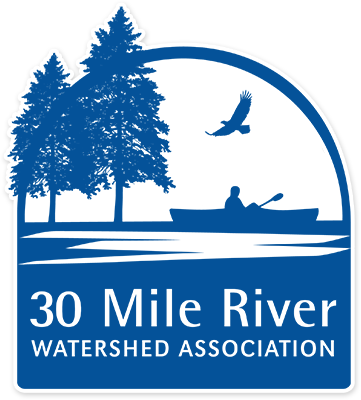What are the impacts of warmer water temperatures?
Algal Blooms: Warmer waters promote the growth of algae in lakes. Cyanobacteria (blue green algae) can quickly bloom in warm, nutrient-rich waters, turning the lake green and creating a health hazard, as many of these species can produce cyanotoxins that are dangerous to humans, pets, and wildlife.
Water Quality: Higher temperatures affect the physical and chemical properties of lake water. Warmer water holds less dissolved oxygen, which is critical for fish and other aquatic organisms. This can lead to hypoxic (low oxygen) or anoxic conditions, stressing or killing fish and other organisms. Anoxia can also lead to a chemical reaction that causes more phosphorus to be released from the lake bottom sediments, which feeds algae.
Fish and Aquatic Life: Many fish species are sensitive to temperature changes. Warmer water temperatures can affect their habitat preferences, spawning behaviors, and overall population dynamics. Cold-water fish species may struggle in warmer waters, which can lead to shifts in fish communities and reduce biodiversity in lakes.
Ice Cover: Warming temperatures can reduce the duration and thickness of ice cover during winter. This impacts winter recreation, as well as ecological processes, like increasing the period of summer stratification. This in turn impacts how long bottom waters are deprived of oxygen, phosphorus levels, and where fish can go.
Ecosystem Dynamics: Changes in lake temperatures can disrupt the timing of biological events such as fish spawning, insect emergence, and plant growth. This can affect the entire food web.
Besides reducing the causes of climate change, and voting for leaders who will work hard to reduce greenhouse gas emissions, what can we do locally?
We must work even harder now reduce the phosphorus getting into lakes from polluted runoff and erosion that occurs every time it rains, especially when we get intense storms that are worsening due to the effects of climate change. Reducing phosphorus is a core focus of 30 Mile’s work.
Gravel roads and driveways are the biggest sources of phosphorus. We need better-designed and maintained road infrastructure, larger culverts and stream crossings, and natural, vegetated stream and shoreline habitats that promote infiltration, reduce erosion, and make our lakes and streams more resilient to the changing climate.
The vegetation on your shoreline is the “last line of defense” in protecting your lake or pond from polluted stormwater runoff (and phosphorus!). Buffers with many tiers of vegetation (ground covers, shrubs, trees) provide the most protection to slow and absorb rain and stormwater from uphill areas. A shoreline buffer not only protects water quality in your lake or pond, but it also provides important wildlife habitat that is vital to aquatic and terrestrial wildlife that live in or near, or rely on the lake ecosystem for survival. Furthermore, a robust buffer shades your rocky shore to help reduce heat pollution and keep the shallows near your shorefront cool during the summer heat. Learn more about vegetated shoreline buffers here.
To provide our lakes, ponds, and streams with the best hope of being able to handle these climate change impacts, it will take action from everyone: the State, town planning boards, code enforcement, road commissioners, public works departments, road associations, contractors, shorefront owners, town residents, and voters.
Learn more about the effects of a changing climate on Maine’s freshwater systems in the recently updated Scientific Assessment of Climate Change and Its Effects in Maine by Maine Climate Council Scientific and Technical Subcommittee, Governor’s Office of Policy Innovation and the Future.

Graphic Source: Scientific Assessment of Climate Change and its Effects in Maine (2024):Figure 1. Maine’s annual mean temperature 1895–2023 based on data from the National Centers for Environmental Information. The dashed linear trendlines show temperature increases of 3.5°F (1.9°C) across the record period. Bold black line represents five-year averages.
This article was included in 30 Mile’s July 2024 newsletter. To view the full newsletter, click here.
